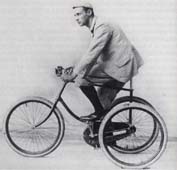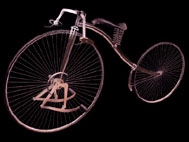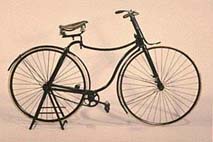|
Part II ---> Part I - Introduction: A Divergence Of Styles In 1891, the Velo-Club Bordelaise - at that time the largest cycling club in France - organized a long distance cycling event on the roads between Bordeaux and Paris. Conscious that a road cycling event of the contemplated distance was unprecedented in France, the event organizers invited the participation of cyclists from Britain, where a long distance road sport had already developed. What the organizers of Bordeaux-Paris had
in mind was a randonnee - a kind of tour, but one conducted at
a rapid pace. The organizers had arranged sleeping In its event structure, its competitive ethic and, above all, its attitude to cycling in company, the British sport has come to be markedly different from the long distance cycling sport that has evolved in France. Accounting for these differences requires an understanding of the development of cycling in Britain and, in particular, an understanding of the legal status of the British road network and of the evolution of the organizations of British cyclists. Though there is no more hotly contested question in cycling history, it is probably fair to say that the first enduring application of a mechanical means of propulsion to a two-wheeled vehicle probably took place in France in the early 1860's. The resulting invention, named the "velocipede", became the basis of a flourishing French industry that, by the end of the decade, had promoted the first inter-city road race (Paris - Rouen) and sponsored the beginnings of a fledgling cycle-sport press. This industry was converted to support the war effort against the Prussians in 1870 with the result that, in the aftermath of the French debacle, these manufacturing firms were completely wiped out. Leadership in cycling passed to the British who came to the forefront in manufacturing and technical innovation. Consequently, by the time of Bordeaux - Paris, cycling was more developed in Britain than in any other nation in the world. In no other country were the raw numbers of cyclists on the road larger than in Britain. The cycling population of 60,000 in 1878 had grown to 400,000 by 1885. While the price of bicycles still made ownership largely a prerogative of the middle classes, the mass manufacture of bicycles towards the last decade of the nineteenth century was beginning to open cycling to a wider swathe of the British populace. This was the
era of the dominance of the "Ordinary" or "high-wheeled"
bicycle. The Ordinary was the machine of choice of most cycling
purists and club racers. However, British cyclists began to organize themselves
nationally in 1878. The organizations of touring cyclists and
racing cyclists were in Britain, from the outset, separate. Touring
cyclists founded the Bicycle Touring Club (soon to be the more
encompassing Cyclists' Touring Club), drawing subscriptions from
individual members. In 1878 as well, the Bicycle Union, an umbrella
grouping of local clubs devoted to social activities and to club
racing, was created. The Tricycle Association, grouping clubs
of tricyclists, came Several models of the "safety" bicycle - notably the lever-driven Facile - preceded the Rover design of 1884, the now familiar diamond frame design of the modern bicycle. The overwhelming success of the "safety", however, had to wait until the introduction of the pneumatic tire in 1888, an innovation that put a decisive end to the three-part division of the bicycle market. By the time of the advent of the "safety", the developments in British cycling that were to influence the shape of the long distance road sport in that country, had already occurred. Part II ---> |


